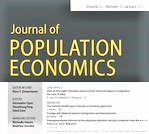A new paper published in the Journal of Population Economics provides a model that can account for the possibly negative correlation between population growth and productivity growth.
Read more in:
Endogenous education and the reversal in the relationship between fertility and economic growth
Alberto Bucci, Klaus Prettner
Journal of Population Economics (2020) 33, Issue 3: 1025-1068
FREE READ LINK
GLO Fellow Klaus Prettner

Author Abstract: To reconcile the predictions of research and development (R&D)-based growth theory regarding the impact of population growth on productivity growth with the available empirical evidence, we propose a tractable, continuous-time, multisector, R&D-based growth model with endogenous education and endogenous fertility. As long as the human capital dilution effect is sufficiently weak, faster population growth may lead to faster aggregate human capital accumulation, to faster technological progress, and, thus, to a higher growth rate of productivity. By contrast, when the human capital dilution effect becomes sufficiently strong, faster population growth slows down aggregate human capital accumulation, dampens the rate of technical change, and, thus, reduces productivity growth. Therefore, the model can account for the possibly negative correlation between population growth and productivity growth in R&D-based growth models depending on the strength of the human capital dilution effect.
Access to the newly published complete Volume 33, Issue 3, July 2020.
LEAD ARTICLE OF ISSUE 3:
Blau, F.D., Kahn, L.M., Brummund, P. et al., Is there still son preference in the United States?.
Journal of Population Economics 33, 709–750 (2020). READ LINK FREE.
https://doi.org/10.1007/s00148-019-00760-7

Ends;

